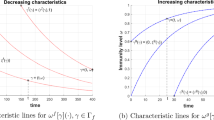Abstract
Our motivation is a mathematical model describing the spatial propagation of an epidemic disease through a population. In this model, the pathogen diversity is structured into two clusters and then the population is divided into eight classes which permits to distinguish between the infected/uninfected population with respect to clusters. In this paper, we prove the weak and the global existence results of the solutions for the considered reaction-diffusion system with Neumann boundary. Next, mathematical Turing formulation and numerical simulations are introduced to show the pattern formation for such systems.
Similar content being viewed by others
References
Allen, L.J.S., Langlais, M., Philipps, C.J.: The dynamics of two viral infections in a single host population with applications to hantavirus. Math. Biosci. 186(2), 191–217 (2003)
Bailey, N.T.J.: The Mathematical Theory of Infectious Diseases and Its Applications, 2nd edn. Hafner, New York (1975)
Barrio, R.A., Verea, C., Aragon, J.L., Maini, P.K.: A two-dimensional numerical study of spatial pattern formation in interaction systems. Bull. Math. Biol. 61, 43–505 (1999)
Busenberg, S., Cooke, K.: Vertically Transmitted Diseases. Biomathematics, vol. 23. Springer, Berlin (1993)
Cattaneo, C.: Sur une forme de l’equation de la chaleur elinant le paradoxe d’une propagation instantance. C. R. Acad. Sci. 247, 431–432 (1958)
Diekmann, O., Hessterbeek, J.A.P.: Mathematical Epidemiology of Infectious Diseases. Mathematical and Computational Biology. Wiley, Chichester (2000)
Gomes, M.G.M., Medley, G.F., Nokes, D.J.: On the determinants of population structure in antigentically diverse pathogens. Proc. R. Soc. Lond. B 269, 227–233 (2002)
Gupta, S., Maiden, M.C.J.: Exploring the evolution of diversity in pathogen populations. Trends Microbiol. 9, 181–185 (2001)
Eden, A., Michaux, B., Rakotoson, J.M.: Doubly nonlinear parabolic equations as dynamical systems. J. Dyn. Differ. Equ. 3(1), 87–131 (1991)
Fitzgibbon, W.E., Langlais, M., Morgan, J.J.: A mathematical model for indirectly transmitted diseases. Math. Biosci. 206(2), 233–248 (2007)
Fromont, E., Pontier, D., Langlais, M.: Dynamics of a feline retrovirus (FeLV) in host populations with variable spatial structure. Proc. R. Soc. Lond. B 265, 1097–1104 (1998)
Hollis, S., Martin, R.H., Pierre, M.: Global existence and boundedness in reaction diffusion systems. SIAM J. Math. Anal. 18, 744–761 (1987)
Ladyzhenskaya, O.A., Solonnikov, V., Ural’ceva, N.: Linear and Quasi-Linear Equations of Parabolic Type. Transl. AMS, vol. 23. Am. Math. Soc., Providence (1968)
Morgan, J.J.: Global existence for semilinear parabolic systems. SIAM J. Math. Anal. 20, 1128–1144 (1989)
Morgan, J.J.: Boundedness and decay results for reaction diffusion systems. SIAM J. Math. Anal. 21, 1172–1184 (1990)
Morgan, J.J., Hollis, S.L.: The existence of periodic solutions to reaction-diffusion systems with periodic data. SIAM J. Math. Anal. 26, 1225–1232 (1995)
Murray, J.D.: Mathematical Biology I: An Introduction, 3rd edn. Springer, Berlin (2003)
Murray, J.D.: Mathematical Biology II: Spatial Models and Biomedical Applications, 3rd edn. Springer, Berlin (2003)
Turing, A.M.: The chemical basis of morphogenesis. Philos. Trans. R. Soc. Lond. B 237, 37–72 (1952)
Simon, J.: Compact sets in the space L p(0,T;B). Ann. Math. Pura Appl. 65–96 (1989)
Author information
Authors and Affiliations
Corresponding author
Rights and permissions
About this article
Cite this article
Bendahmane, M., Saad, M. Mathematical Analysis and Pattern Formation for a Partial Immune System Modeling the Spread of an Epidemic Disease. Acta Appl Math 115, 17–42 (2011). https://doi.org/10.1007/s10440-010-9569-3
Received:
Accepted:
Published:
Issue Date:
DOI: https://doi.org/10.1007/s10440-010-9569-3




